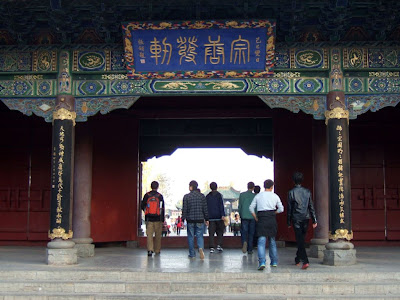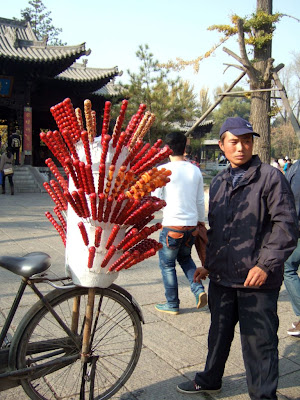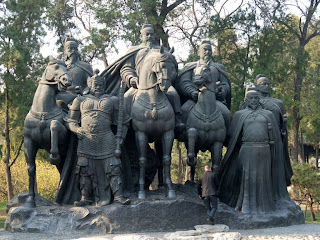
Jin-Ci (晋祠), The historical Ancestral Temple Garden was located 16 miles south west of Taiyuan City. It was first built in 1500 years ago during Northern Wei period (386-533), and later extended, renovated, restored in several following dynasties. The Complex comprises a large garden including bridges, pavilions and terraces in addition to its diverse collection of 98 buildings, 110 sculptures and artifacts. It is quite rare for so many fine relics to be preserved in one cultural heritage. Jin-Ci is a place with combination of history, cultural relics and beautiful landscapes.


The site of Jin-ci is a large park comprising of a classical garden with lake, pavilions, halls and temples from various dynasties began from Song (960-1279).


Jin-ci (晋祠) sitting at the foot of Xuan-weng Mountain, has a collection of stately grandeur and elegant beauty ancestral architecture and natural heritage.


Hearing the name Jin-Ci, we did not expect such a fascinating garden like this.



Jin-ci Temple (晋祠) to a certain extent was an awesome imperial garden.


It covers a total area of about 3000 acres of land.


Some of its gorgeous Pavilions !



Northern Chinese delicacy skewer fruit candy hawkerstore became part of the scenery.



It really needs a day or at least half to stroll through the grounds.



Taiyuan people are still considered as quite fortunate as they possess such a magnificent garden inside the city for them to escape from the environmentally high polluted town.


A tradition ancient garden with beautiful natural landscape.



The trees are definitely one of the factors that make the sight attractive.


Visiting garden is free but to have deep exploration into the historical sight, starting from this gate, you need a ticket chargeable at 70 rmb.


To enter into the central main hall, there are three different routes via north end from Wen-Chang Pavilion (文昌宫) or via south end from Yin-sheng (瀛胜楼)or go through the center axis direct to main places of interest.



The site is planting with more than 20k precious species of rare trees and floral plants.



The two Chinese character Tang Yard (唐园) was the hand writing of the Ming/Qing famous calligrapher Fu-Shan (傅山). Most of the buildings at this park was rebuilt recently in year 2007.



The three layers Pavilion at Tang Yard was believed to be the spot area when Li-Shimin and his successor Li-yuan began their conquer and gain the kingdom of Tang Dynasty. The first layer of the structure was named as Fei-Long-Ge (飞龙阁) and the 2nd layer was named Ling-Yun-Ge (凌云阁), both had the meaning of high in position above common people.



The watch tower at the top of Fei-Long Pavilion was named as Guan-fen (观汾) as you are able to have a panoramic view of Fen River, the mother river of Shanxi. The man-made stone hill with a narrow tunnel for you to cut through the pavilion at the base was interesting.



The carved Stone Wall Screen measured at 8.4 meter wide by 5 meter in height, though its a replica product, it is large enough to attract some attention.


The stone wall screen was carved with pictures of celestial beings, the three Fortune Gods of happiness, prosperity and longevity (福禄寿) on one side and the Chinese mythology 8 in-mortals crossing the ocean (八仙过海) on the other side.



Taiyuan was originally named as Jinyang and it was nicknamed as City of Dragon. The 4 Chinese ancient calligraphy (龙兴晋阳 Long-xing-jinyang) hanged on this new building means The dragon prospered the city.


Most of these building structures in the garden were constructed in year 2007.



The group brass sculptures of Li-Shiming, the founder of Tang Dynasty and his generals were built by Taiyuan State Government, who spent 27 millions rmb and used up 23 ton of brass material to get this done.



We were more fascinated by the garden sight rather than those newly constructed structure.



Stone carved ancient character of dragon (龙 sound long) at the garden pavilion.


Enjoy some scenic sight of the temple garden.










The holy water lily pond.


Fulong Hill was made in year 1933 with a 8 columns round pavilion at the top. An irregular sized fish pond was built at the foot with a stone tiger in a posture of drinking water by the side. There are two stone fish, some stone angels inside the pond and a dragon crawling at the hill. The two Arahat known as Dragon Defeater and Tiger Controller, standing below the dragon are made from white jade.



The mouth of the dragon and fish, the flower basket of the angels and the alms of the monks are actually the water fountains of the Fulong Hill Pond.


The hand writing of the famous calligrapher from Ming/Qing Dynasty was again shown in the name plague of Peony Pavilion. The three Chinese character (牡丹亭) was written by him.


Surrounded Peony Pavilion is a garden of rare plants.


Imagine if it was now the blossom period of the peony, how colorful and beautiful would be this garden!



Some rare trees at Peony Garden.


Though long and winding corridors look new in this old temple garden, they are not awful but serve the purpose in connecting people from one place to another.


Beautifully designed new corridors can be met in various parts in the temple garden.



Viewing from outside, these old corridors appear like a series of train coaches amidst in a forest of colors.



A serene natural lake at this corner of the temple site.



A scenic sight was formed with existing of this beautiful lake.



This is the south route connected to Saint Mother Hall via Never Aging Spring Pavilion and also it is the existing pathway to get out from Jin-Ci Garden.




Some commercial stores selling souvenir, local snacks and fruits along the exist way.




No comments:
Post a Comment